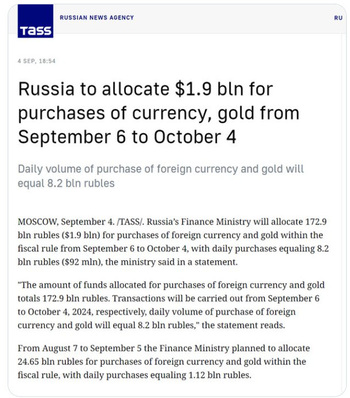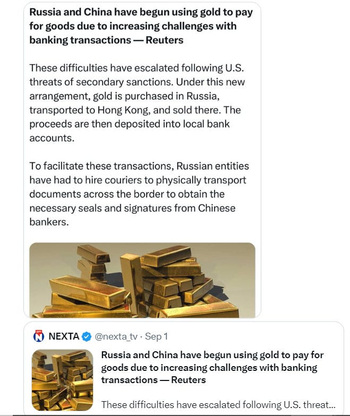As the West exploits the dollar-based global financial system to crack down on its perceived enemies, Russia is building its own workarounds… using physical gold and oil.
As for gold, it’s acquired in Russia, transported to Hong Kong, and then sold. The proceeds from these sales are then deposited into local bank accounts.
Now comes another big headline.
Per the article screenshotted below, the Russia News Agency announced yesterday it will increase its gold purchases from 1.12 billion rubles per day to 8.2 billion rubles per day over the next month, starting tomorrow (Friday).

This large daily gold purchase amount (8.2 billion rubles) is approximately 7.32 times the smaller previous amount (1.12 billion). In Federal Reserve notes, that’s $92 million in official Russian gold purchases daily, or about 1100 kilos per day.
That’s an increase of 632% over Russia’s recent rate of gold purchases.
As reported in the Jerusalem Post, the Russian finance ministry expects a significant increase in oil and gas revenue which is the funding source for the new gold purchases.

According to recent reports, Russia and China have increasingly turned to using gold as a means of payment for goods thanks to their mounting challenges in conducting traditional banking transactions as a direct result of U.S. sanctions and threats of secondary sanctions on entities dealing with Russia.
The gold workaround involves a multi-step process.
First, gold is purchased in Russia often connected with sale of Russian oil and gas. It is then transported to Hong Kong, where it is sold. The proceeds from these sales are subsequently deposited into local bank accounts.
This little workaround allows both countries to continue trade relations while circumventing restrictions on conventional financial channels.
The process has not been without its complications. Russian entities have had to resort to hiring couriers to physically transport documents across the border to obtain necessary seals and signatures from Chinese bankers.
This highly manual process shows the lengths to which these countries have resorted to maintain economic ties in the face of international hostility and crackdowns.
As geopolitical pressures continue to mount, it’s likely that we’ll see further innovations in physical cross-border transactions and other creative trade mechanisms between sanctioned countries and their partners. And it’s likely we will see a further response from the U.S.
Another Russia Workaround: Using Oil as Payment
Meanwhile, according to leaked documents obtained by the Financial Times, Russia has established a covert trade channel with India to acquire sensitive goods as well as explore the possibility of building facilities in the country to secure components for its war efforts.
Russia is seeking to obtain sensitive goods from India, including electronics that could potentially be used for military purposes. The trade involves India selling critical electronics to Russia in exchange for oil.
- Such arrangements allow Russia to circumvent Western sanctions and obtain necessary components for its military operations — and to support its domestic economy in the face of U.S. efforts to destroy it.
- India benefits from discounted oil prices while gaining a market for its electronics industry.
While the India-Russia trade channel has been described as “secret,” some commentators argue that it was a known consequence of sanctions, with the intention of reducing Russian profits while allowing oil products to reach secondary markets.
Given Russia is the world’s largest oil producer, second only to China, the potential to use oil as an effective currency is significant.
Fiat Currency Is the TRUE Shady Workaround
I frequently encounter skeptics I call “gold bashers.” These critics dismiss gold as an “ancient relic” or “boomer rock,” questioning its practicality in modern transactions.
These skeptics seem to have fallen victim to the intentional gaslighting orchestrated by fiat currency proponents, who aim to suppress interest in alternatives to Federal Reserve notes and financialized products.
As a gold analyst, I find profound irony in the characterization of using hard assets like gold or even oil as a “workaround” for international trade. In fact, one could argue that it is fiat currency that represents the true “workaround” in the history of monetary systems.
Gold has served as a universal medium of exchange and store of value for millennia, long before the advent of modern banking, electronic payment systems, and fiat currencies. Goid’s intrinsic value, scarcity, resiliency, fungibility, portability, pisibility, utility, ductility, malleability, and durability made it the natural choice for facilitating trade across borders and cultures.
Fiat currencies, on the other hand, are relatively recent inventions, backed solely by government decree rather than inherent value.
At first, bills were floated by banks as substitutes for gold, essentially serving as promissory notes for real money — gold itself. That promise of gold redeemability was subsequently broken, leaving just the floating fiat currency.
In this light, the return to gold-based transactions between Russia and China isn’t so much a workaround as it is a reversion to a more fundamental and time-tested form of economic exchange.
It highlights the enduring value of gold as a reliable store of wealth and medium of trade, especially in times of geopolitical uncertainty and financial restrictions.